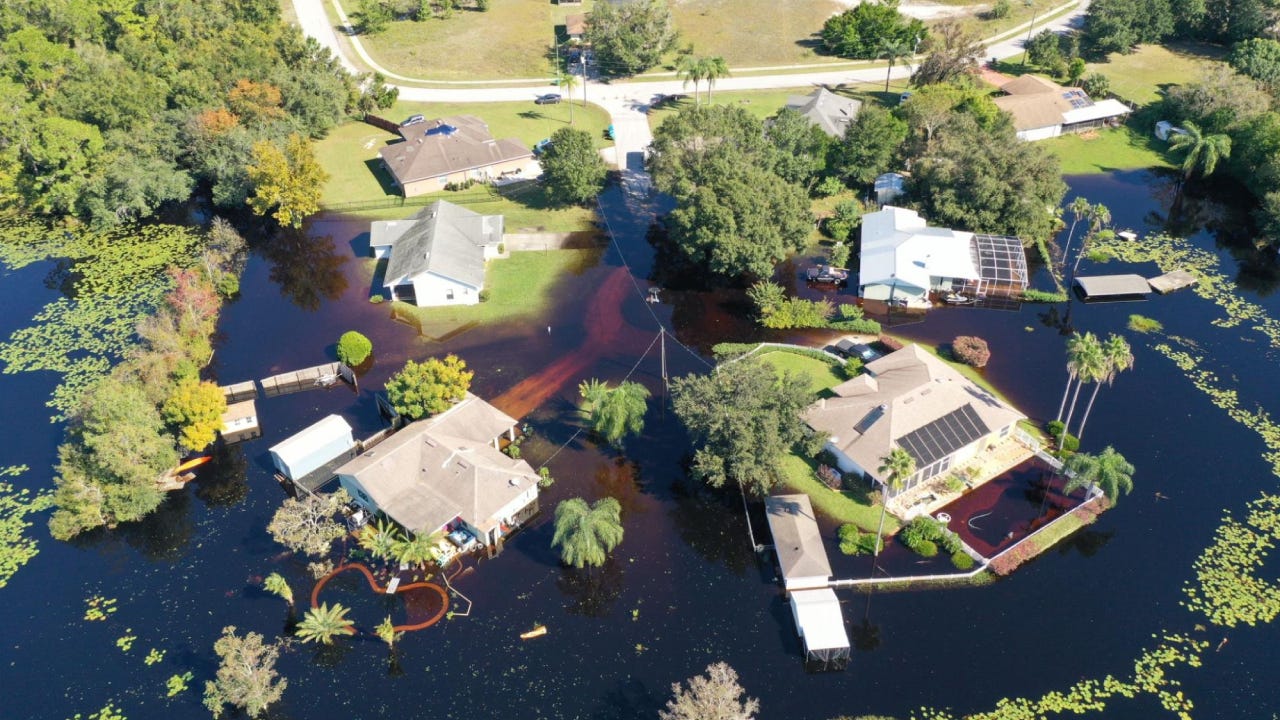Florida remains hot housing destination despite home insurance crisis

Americans are flocking to Florida for more than just vacations. According to the U.S. Census Bureau, Florida gained 365,205 new residents between 2022 and 2023.
Living in a beach paradise may come at a price not all new Florida homeowners are aware of — and it may be more than they can pay. Florida is already notorious for catastrophic disasters and a challenging home insurance market. With the increased frequency and severity of extreme weather, rampant insurance fraud and inflated rebuilding costs, Florida has lost over 30 insurance providers in the past three years, adding to the ever-growing Florida homeowners insurance crisis.
Thousands of Americans are moving to Florida
Florida’s population has consistently increased since 1946, with the most substantial growth from 1950 to 1960. Since then, other states like Nevada, Idaho and Alaska have topped the list as fastest-growing states until 2022, when Florida saw a 1.9 percent population increase. The Florida Chamber of Commerce predicts that 2024 may bring an additional 225,000 more new residents.
Why are people moving to Florida?
Florida is one of a few states that does not have a state income tax or a payroll tax and businesses only pay 5.5 percent in corporate income tax, making it a business-friendly environment. Additionally, the cost of living in Florida is within a few percentage points of the national average in many categories, making it a fairly cheap option for everyday expenses.
According to Mike Shoaff, a real estate associate with RE/MAX, affordability and mild weather are big draws, but many homeowners moving from out of state also prefer Florida’s political climate to their home states. The COVID-19 pandemic may have given many Americans who previously had their eye on Florida the final nudge they needed to actually make the move.
In 2020, the pandemic prompted many to move to Florida to be with family, to secure affordable housing and to find jobs since so many other states enacted mandatory shutdowns of non-essential businesses. By 2021, there was an influx in remote work, and many Americans in their 20s and 30s seized this opportunity to take their job with them to a state where they could do more with their money.
Data show that 91,758 New York residents migrated to Florida in 2021 — the most from any state. When comparing the most expensive cities from both states, New York City and Fort Lauderdale, Fort Lauderdale has an average cost of living that is 46 percent lower than New York City.
The cost of living in Florida
As with many states that experience quick growth, the low cost of housing that drew many to Florida is now becoming out of reach for the average Floridian. In 2019, the median household income for Florida was $59,200, with a median home sale price of $241,400. In 2021, the same person looking for a home earned $61,000, but the same home would cost $304,100. These home price increases are in addition to rapidly increasing home insurance costs in many areas of the state.
This trend is even dissuading many seniors from choosing Florida for a sunny retirement. Despite its reputation as a retirement destination, Florida doesn’t even rank in our top five best places to retire list since the cost of insurance, home values and risk of financial ruin from a natural disaster may be difficult to afford on a fixed budget.
When contemplating the cost of living in a new state, auto and home insurance costs are just as important as gas, food, taxes and other day-to-day expenditures. Floridians pay more for home, flood and auto insurance than the national average. Depending on location and personal characteristics, you may pay over $1,100 more per year than the national average for full coverage car insurance and $500 more per year for home insurance with $250K in dwelling coverage.
The Florida insurance crisis
Tornadoes, flooding, hurricanes and tropical storms create a challenging market for insurance companies. The National Centers for Environmental Information shows that 22 extreme weather events impacted Florida between 2019 and 2023, costing an adjusted $239.5 billion. Due to the increased risk of loss, many big names in homeowners insurance, like Farmers and AAA, have withdrawn from the state, and smaller insurance providers have become insolvent.
These same weather risks also contribute to higher auto insurance rates. Florida has a high rate of uninsured drivers and a high fatal accident rate, which also tends to drive up premiums. This, combined with economic factors like high inflation and labor shortages, results in average full coverage car insurance premiums that are 55 percent above the national average.
Insurers pulling out of Florida put a heavy financial burden on the remaining providers, which is passed down to homeowners. This usually translates to increased premiums and stricter underwriting qualifications. On average, Florida property owners pay a combined $5,825 a year for their auto and homeowners insurance, depending on location and several other risk factors. With flood coverage, average costs are over $6,500 per year.
Fewer insurance options leave Americans looking to move to Florida unable to actually buy a house in certain areas because homeowners insurance is usually required when getting a mortgage. Existing homeowners in high-risk zones and coastal areas are also contemplating selling their homes due to their home insurance premiums skyrocketing. Property owners who can’t secure home insurance are relegated to purchasing Citizens Insurance, the option of last resort. To be eligible for a Citizens policy, homeowners must show that they cannot find coverage with another carrier or that the quote from a private insurer is at least 20 percent more than a Citizens policy.
While the property insurance crisis becomes more tenuous for average Floridians, Shoaff told us that he sees mixed reactions when asked if homebuyers moving into Florida are concerned about the cost of insurance.
If a buyer is looking to spend millions on a condo or home, they do not seem worried about the insurance or catastrophic loss potential. The other half of our buyers are the ones who are very worried, especially with the cost of insurance and all the details of what is insurable and what is not.— Mike Shoaff, Florida real estate associate with RE/MAX
The added cost of flood insurance
About 40 percent of the hurricanes that make landfall in the U.S. hit Florida. Since Southern Florida is only about 60 miles wide, flood insurance may be crucial even if your home is in an area that hasn’t had severe flooding yet. Flood damage is excluded from standard home insurance policies but is often required by mortgage companies for homes in at-risk areas. Homeowners can purchase flood insurance through either a private insurer or the National Flood Insurance Program (NFIP), the government-backed flood program.
National Flood Insurance Program
The national average cost of an NFIP policy is $888 per year. In recent years, the NFIP adjusted flood insurance costs to meet their new risk-based cost of insurance estimates. This rating system, called Risk Rating 2.0, means that most policyholders will continue to see rate increases up to a maximum of 18 percent year over year until their premium lines up with their risk-based coverage cost.
The average cost of an NFIP policy in Florida is $958 and the risk-based cost is $2,213 for a single-family home. When considering a move to Florida, it is vital to factor in the possibility of your flood insurance and other coverage premiums increasing every year.
Private flood insurance
Securing flood insurance with a private insurance company allows policyholders to have more flexibility in coverage options and potentially save on their premiums. Private flood insurance can be hard to come by in Florida and may be more expensive than an NFIP policy. Kin and Tower Hill Insurance Exchange are unique options in Florida that allow homeowners to purchase home insurance and add a flood endorsement instead of a separate flood policy.
Since Kin is transparent with its insurance pricing, we can compare the price difference between a private flood policy with one purchased through the NFIP. Fort Myers is one of Florida’s most popular cities and is located in Lee County. Kin’s average annual cost of flood insurance for Lee County is $4,050. The current average premium for flood insurance in the county is $1,285 per the NFIP, but the average risk-based cost is $3,965. So ultimately, there is only an $85 difference between a private or government-backed policy in this instance.
We spoke with Angel Conlin, the chief insurance and compliance officer at Kin, about when Florida insurance premiums may plateau.
While challenges persist, change is happening. Legislative reforms, data-driven strategies and proactive risk reduction efforts are shaping a promising path. It might not be an overnight transformation, but a more affordable horizon awaits potential homeowners in the Sunshine State.— Angel Conlin, Chief Insurance and Compliance Officer at Kin
How climate change is impacting Florida’s insurance landscape
While insurance companies and legislators navigate a more stable insurance future for Florida, climate change is rapidly exacerbating the situation. The National Oceanic and Atmospheric Administration (NOAA) predicts that Florida will see a 1-foot increase in sea levels by 2050 and 2 feet by 2100. Sea level rise puts more areas of Florida at risk for storm surge damage. Simultaneously, climate change is causing a larger proportion of storms to reach Category 3 to 5 classifications and speeding up the rate at which these storms intensify.
Since 1980, Florida has experienced an adjusted $370 billion in disaster-related loss, mostly hurricane-related. In that 40-year time frame, every part of Florida’s coastline has experienced at least one hurricane.
Bankrate’s Housing Heat Index discovered four of the 10 most popular metro areas people are moving to are in Florida. All four of these areas are coastal regions with high potential hurricane exposure. This indicates that the regions experiencing the most growth in Florida are potentially some of the most challenging to secure home coverage. NOAA notably states that population growth and infrastructure development to support that growth in coastal areas is the most significant influencing factor of future hurricane risk.
How is the state addressing Florida’s home insurance problems?
Citizens Insurance, which was designed by the state for homeowners to use as a backup plan, now owns 50 percent of the market share over any private insurance company. If a loss occurs and Citizens does not have enough premium in reserves to honor claims, rates will increase. By law, a Citizens Policyholder Surcharge will be assessed on homeowners, auto, specialty and surplus lines policies for up to five years to replenish reserve funds.
In December 2022 and March 2023, Florida passed a total of 10 laws focused on property insurance reform. These laws aim to limit the opportunity for fraud and frivolous lawsuits. They also support increasing the cost of Citizens Insurance so that private insurers are a more competitive option for homeowners. Once more insurance options are available, many are hopeful the cost of insurance will naturally stabilize.
According to Tasha Carter, Florida’s insurance consumer advocate, “The Florida Legislature has taken significant steps to pass laws that will create a viable, competitive and affordable homeowners insurance market and reduce insurance rates.”
As of October 2023, new insurance companies have been approved by the state to offer homeowners insurance in Florida. Slide Insurance, TypTap Insurance and others made offers to over 150,000 Citizen policyholders to move their coverage over to private insurance.
Depopulation of Citizens policies is key to reducing the amount of risk Citizens is assuming and encouraging more companies to return to Florida. As of February 2024, Citizens had 1,169,427 policies in force, which is an improvement from September 2023 when it had 1,407,805 policies in force.
The state is becoming a more attractive business environment. Increased competition leads to more capacity and options for consumers and lower insurance rates. I am hopeful that the recent changes will have a significant, positive impact on the state’s homeowners insurance market.— Tasha Carter, Florida’s insurance consumer advocate
Insurance tips for Florida homeowners
Making plans about where to live based on what might happen 100 years from now is challenging. Wanting to be near family and beautiful scenery is a sentiment real estate agents hear often, and money, disasters and politics usually can’t change that.
If you already live in Florida or you’re set on moving to the Sunshine State, consider this checklist to help you prepare for homeownership:
- Consider your coverage needs and deductibles: Along with selecting appropriate and affordable coverage types and limits, carefully consider your deductibles. When a claim occurs, you still need to pay for your auto and home insurance deductibles, which can run between $500 and $2,000 per policy. Most Floridians have a separate wind or hurricane deductible for their home policy. Since these are percentages of the dwelling coverage instead of a flat deductible, a 2 percent wind deductible on a home with $250,000 in dwelling coverage would be $5,000.
- Compare auto and home insurance quotes: Compare rates for areas where you potentially want to buy a home and insure a vehicle. This may help you understand risk factors in specific areas and find the best price for the coverage you need. For flood coverage, FEMA allows the public to access the NFIP’s average cost of flood insurance for every state online.
- Look for homes with damage-mitigating features: Any home without wind-mitigation features will likely cost more to insure. With how often extreme weather happens in Florida, buying a home that needs a new roof, raised foundation or any other expensive modifications to become more “hurricane-proof” may not be advisable unless these changes can be made immediately.
- Use First Street Foundation’s Flood Factor tool: This tool can show if your potential home is in a risky flood area. This can be a helpful resource as you map out where you may want to purchase property in Florida.
- Consider future climate risks: Take advantage of other online tools like ClimateCheck, which projects the impact of climate change in a specific location over 30 years. This may help you find a community that is less likely to be impacted by rising seas and extreme weather.
Why we ask for feedback Your feedback helps us improve our content and services. It takes less than a minute to complete.
Your responses are anonymous and will only be used for improving our website.
You may also like

What happens to your life insurance when you leave a job?

First-time homebuyer qualifications

How to save on car insurance: 7 ways to lower your rate



